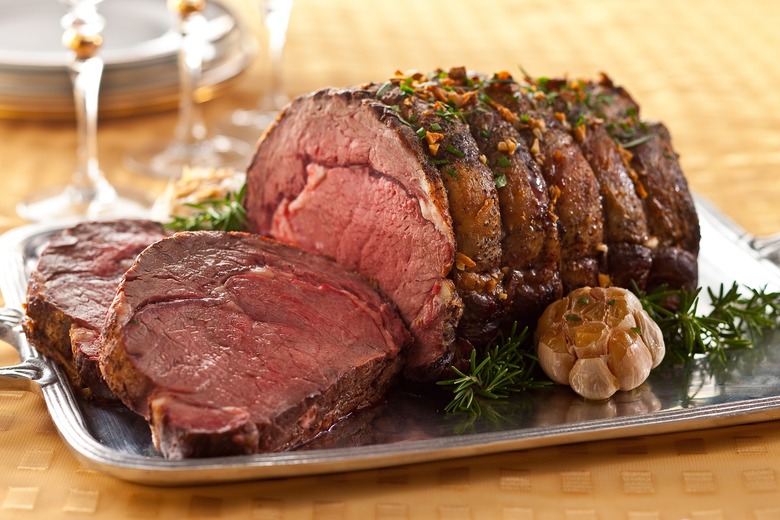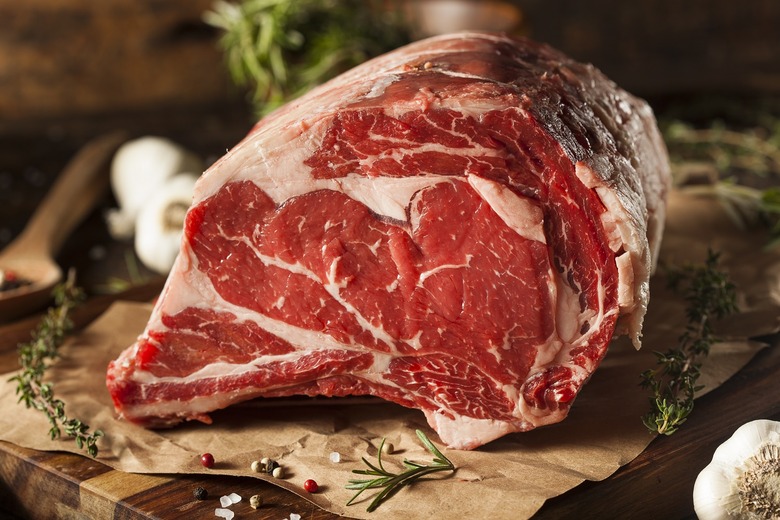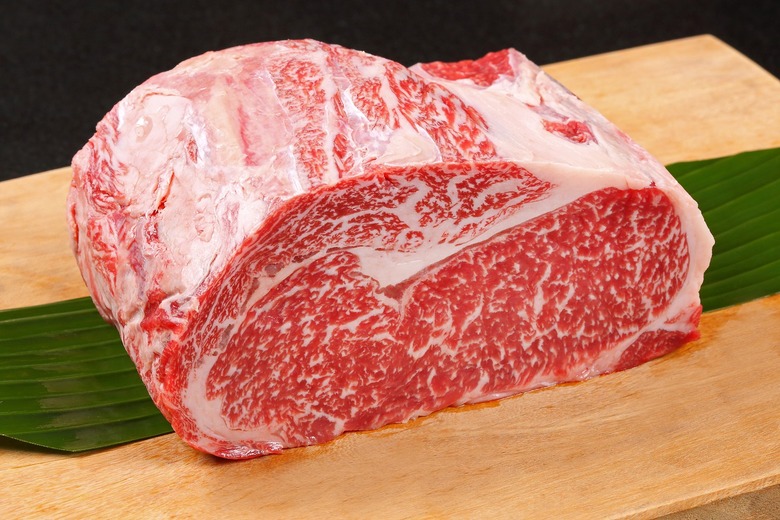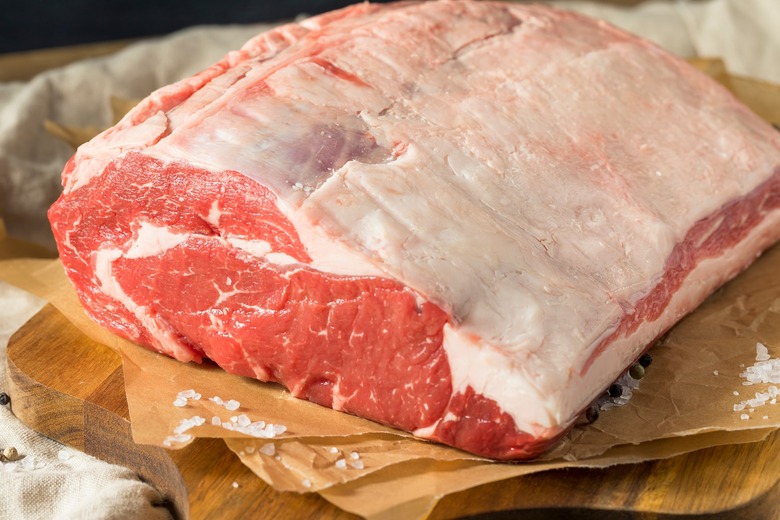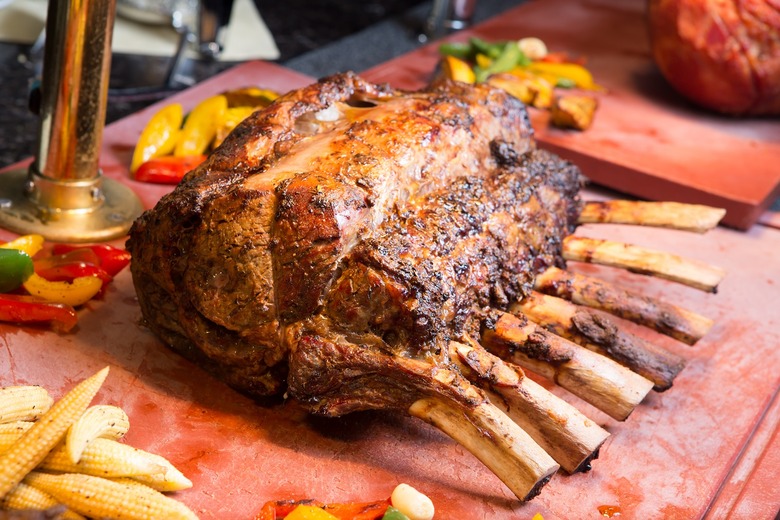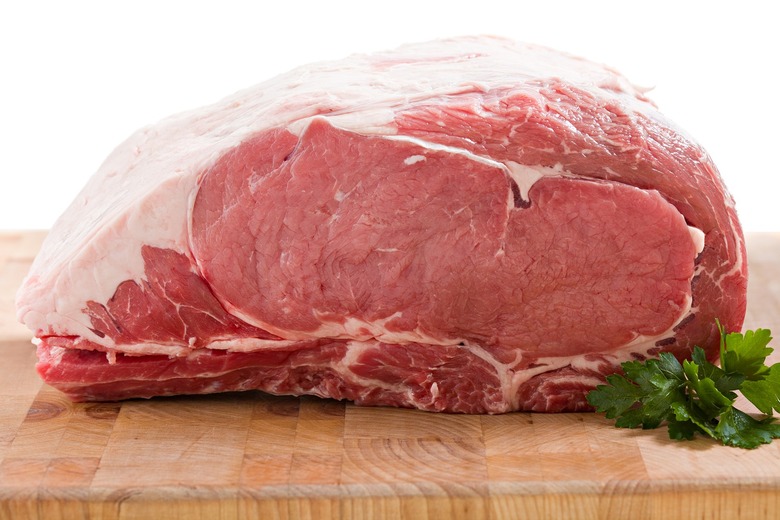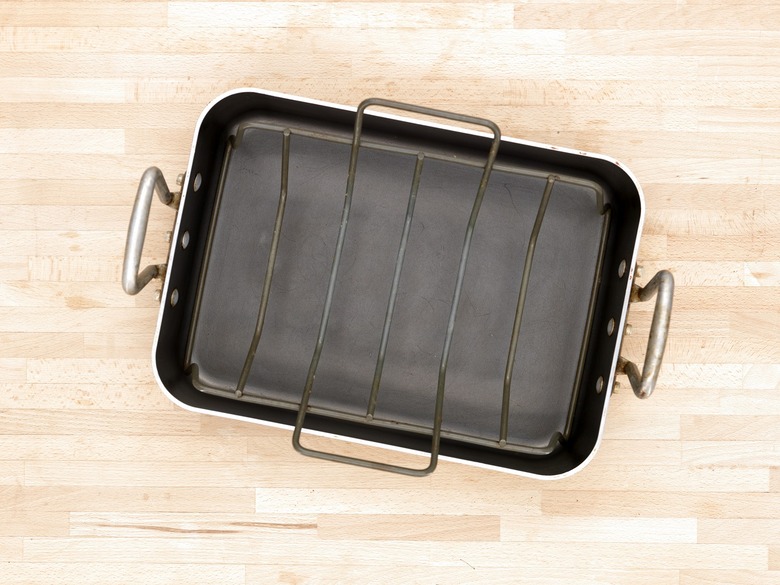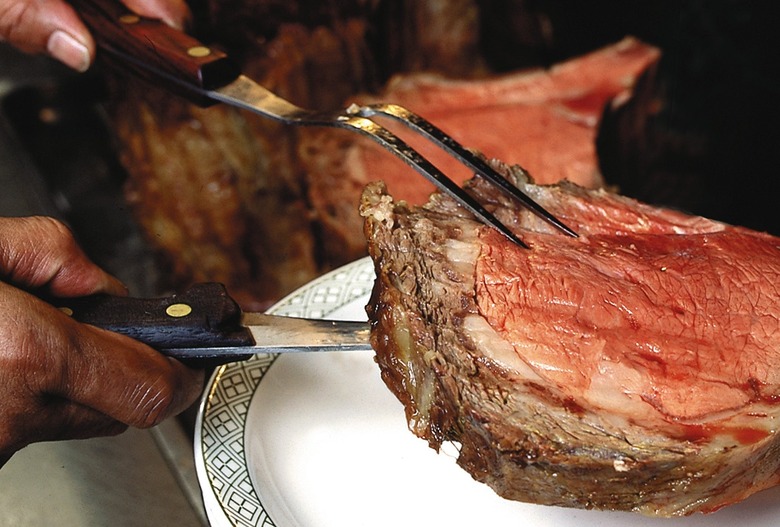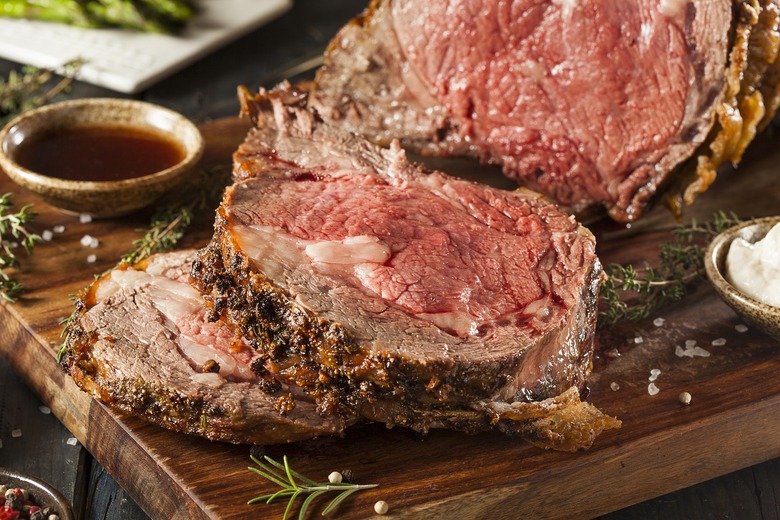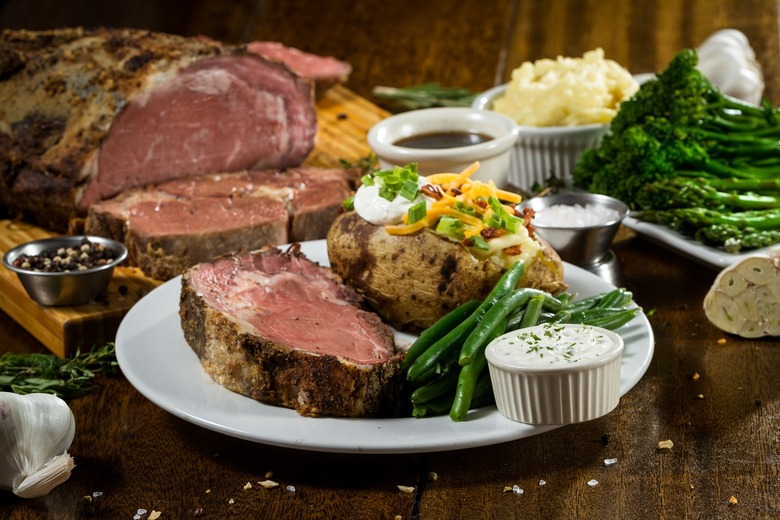How To Cook Prime Rib Perfectly
When it comes to the king of Christmas meats, few entrees can best a classic prime rib. Also known as standing rib roast, prime rib is easy to prepare yet often suffers from over- or under-seasoning and — the ultimate sin — overcooking. And with so many decisions (prime or choice? Bone-in or boneless? What tools do I need?) getting started can feel overwhelming. Whether you've made prime rib before and want to up your game or are looking to recreate a family favorite on your own for the first time, we've got you covered. From picking the best piece of meat to cooking it to perfection, here's everything you need to know.
What is prime rib?
The confusion around prime rib starts with its definition. Also known as beef rib roast and standing rib roast, prime rib refers to the rib section of the cow that has been cut between the fifth and 12th ribs. If you cut a steak from between the rib bones, then you've got a rib-eye steak (New York strip and Delmonico cuts also come from this part of town). If you keep it all together, then it's a roast. The name standing rib roast comes from the fact that it is traditionally cooked standing on the rib bones. Prime rib has it all going on; it's the most tender cut of beef after the nearby tenderloin, but because it has more marbling (aka fat), it is way more flavorful than its lean cousin.
What to consider when buying prime rib
To get the lowdown on all things prime rib, we spoke with Chef Isaac Toups of Toups' Meatery in New Orleans. His No. 1 tip for buying prime rib is to splurge on a high-quality piece of beef, if you're able. Prime rib doesn't come cheap — which is why it's typically reserved for special occasions — and so Toups said that if you're going to go for it, you should go all out. "Find a good butcher, someone you trust. Find well-marbled meat," he said. "If you get the best piece of meat and you mess it up a little bit, you're still going to have a good steak. But if you start with grade C meat, no matter what you do with it, it's never going to be above a C."
Choice, prime or select?
When shopping for prime rib, you'll likely see different grades of beef: prime, choice and select. Despite its name, not all prime rib is prime (in this case, prime refers to the fact that it is the best cut of the rib section, not the grade of meat). Prime beef, which is the highest quality, comes from young, well-fed cattle. It has a good amount of fat marbling, which gives the meat extra tenderness and flavor. Prime cuts of beef are more expensive and you'll likely need to head to a high-end butcher shop to find prime-grade prime rib, but the extra effort and increase in quality is well worth it, says Toups. If you find a prime standing rib roast that has been dry aged, all the better. (Alternately, you can do it yourself by patting the raw meat dry, generously salting it, then letting it age, uncovered, in the back of your fridge for a few days.)
Looking for a more budget-friendly option? Choice cuts of prime rib are more readily available at grocery stores (especially higher-end ones) and are still good quality, though they are leaner and thus have a less luxurious texture. However, it can still be quite tender and delicious when cooked with care. Select-grade beef is the leanest and lowest grade; it is the least expensive option as well as most common at typical grocery stores. Though this is what shows up on many holiday tables, if you can splurge for a higher grade, you will be able to taste the difference.
Is wagyu worth it?
While the average home cook is going to debate between choice or prime cuts of prime rib, Toups recommended wagyu prime rib if you can find — and afford — it. "Wagyu goes even further," he said. "They take these cows, and they really pamper them and feed them a bunch of grain instead of grass. There's always the argument between grass- and grain-fed beef. Grass, which is what they naturally eat, is going to have more of a high-quality beef flavor. Grain is going to give you more of a fat content. So you're always kind of trading. If you go with wagyu, which is grain-fed, it's going to have more fat and it's going to be more luxurious, more melt-in-your-mouth." Though there are times when grass-fed is preferable, for standing rib roast, the more marbling the better. However, keep in mind that wagyu prime rib is quite expensive and can be as much as $100 a pound.
First cut or second cut?
Few people buy a full 25-pound beef rib roast, so your next decision will likely be whether to get the first cut or the second cut. The first cut, which can also be called the loin end or the small end, is, well, closer to the loin. It has a single rib-eye muscle, which makes it more uniform and tender, and thus typically more desirable. The second cut has different muscles instead of just the one and has more connective tissue. It's still delicious and features fatty pockets, which can add flavor and thus makes it a favorite for some.
Bone-in or boneless?
Yes, the choices keep coming. You may next have to decide between bone-in and boneless prime rib. It's hard to go wrong here, so it's really a matter of preference. While some argue that the bone helps insulate the meat and fat, and thus produce a more tender finished product, Toups said that especially for the home cook, boneless is the way to go. "For prime rib, considering you're going to want to slice it and display it, you want no bones," he said. "Otherwise, you have to remove that bone once it is cooked, and you'll expose a whole side that has been fileted open without any of that good, roasty part. That roasted part on the outside of the prime rib is the best part."
How much prime rib to buy per person?
For a boneless prime rib, plan on about half a pound of meat per person.
What to do with the prime rib fat cap?
Prime rib comes with a fat cap, and while you want some fat on it (it helps keep the meat from drying out), according to Toups, "too much is too much." He recommended leaving a half-inch of the fat cap on. You can ask the butcher to trim it for you or do it yourself if you're confident in your knife skills.
Tools needed to cook prime rib
Though prime rib can be an intimidating and expensive cut of meat, you really only need a few essential kitchen tools to cook it properly. "All you need is a large roasting pan with at least 2-inch high sides," Toups said. "And you need your oven at your absolute highest temperature. You need good kosher salt and fresh ground black pepper — I can't stress fresh ground black pepper hard enough." We also recommend using an instant-read thermometer to make sure the meat comes to the exact internal temperature you want for desired doneness. A good carving knife and large cutting board will also come in handy.
How to cook prime rib
Much like with turkey, you may stress over how to cook prime rib, but the majority of recipes keep it pretty simple. For instance, the classic prime rib from Chicago's Lawry's the Prime Rib restaurant uses just two ingredients: seasoned salt and prime rib. As per Toups' recommendation, you may also want to season this roast with freshly ground black pepper. From there, preheat your oven to 450 degrees F and roast your prime rib for 30 minutes. Then, reduce the temperature to 350 degrees and roast an additional 30 to 90 minutes, or until your roast reaches your desired level of doneness, checking about every half hour. Finally, let the meat rest for 20 minutes (be patient!) and carve.
How to tell when prime rib is done cooking
The ultimate goal with prime rib is to have a richly browned crust with a juicy, tender center. The key to delicious prime rib is making sure that the meat is cooked to your desired level of doneness, not by time. For rare meat, cook to 120 degrees F; for medium-rare meat, cook to 130 degrees; for medium meat, cook to 135-140; for medium-well meat, cook to 145; and for well-done meat, cook to 155 (but note that anything above medium-rare is considered sacrilege in many circles when it comes to standing rib roast). Feel free to remove the meat from the oven when it's about 5 degrees below your preferred temperature since the internal temperature will rise as it rests.
What to serve with prime rib
You can serve prime rib with any number of classic holiday sides, from holiday casseroles to twice-baked potatoes to perfectly roasted Brussels sprouts (in case you want some green on your plate). Not sure what else to make this season? Consider 101 of our best holiday recipes.
More from The Daily Meal:
Ways to Cook a Turkey: Roasting, Deep-Frying and Everything In Between
How to Cook Chicken, Turkey, Steak and 12 Other Foods Correctly
Potato Recipes for Cheesy, Mashed and More
